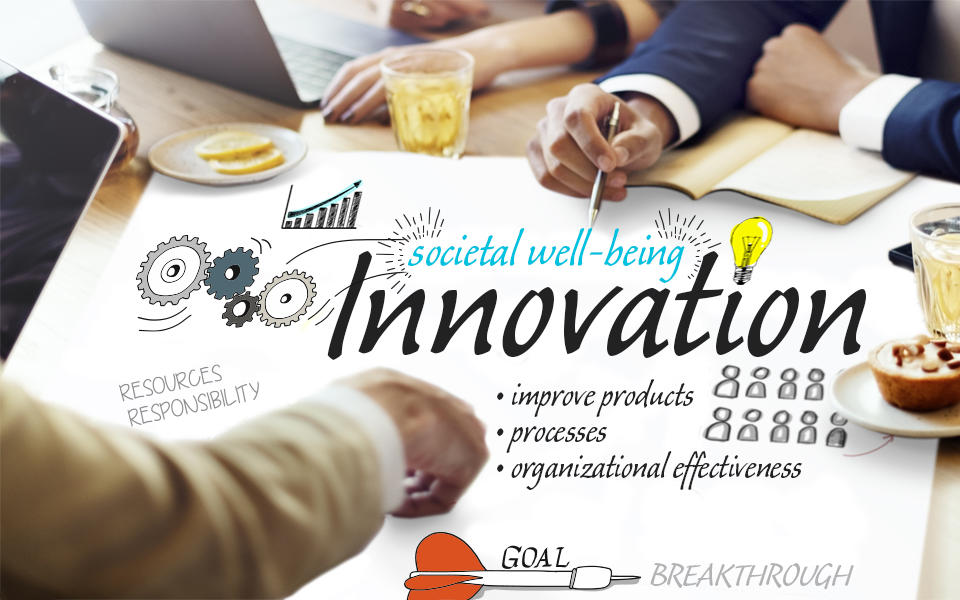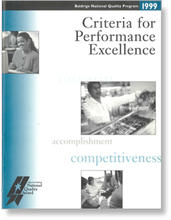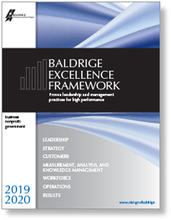Blogrige
The Official Baldrige Blog


In those Criteria, we asked one simple question related to innovation:
- How do senior leaders establish and reinforce an environment for empowerment and innovation?
The Criteria have evolved significantly in the intervening twenty years, including significantly greater emphasis on innovation, starting with the addition of Managing for Innovation as a core value in 2000. The current Baldrige definition of innovation has not changed significantly since 2005. The definition in the 2019-2020 Baldrige Excellence Framework and the 2019-2020 Baldrige Excellence Builder Glossary is:
- Making meaningful change to improve products, processes, or organizational effectiveness and create new value for stakeholders. The outcome of innovation is a discontinuous or breakthrough change.
Is the Definition Still Appropriate?
Readings over the last few years and observations of people's behaviors and organizational strategy lead me to believe that this definition is no longer sufficient. Let me share some data.
- From a recent article in Deloitte Insights based on their 2018 Global Human Capital Trends study, "Stakeholders today are taking an intense look at organizations' impact on society, and their expectations for good corporate citizenship are rising. In an effort to meet these expectations, leading organizations are making citizenship a core part of their strategy and identity." Deloitte concludes that corporate citizenship is now a CEO-level business strategy. Furthermore, a lack of commitment to societal responsibility can quickly damage a company's reputation, sales and its ability to attract workers.
- Millennials currently comprise more than half the workforce in many countries. According to a 2017 Deloitte study, 88% of millennials believe their employers should play a vital role in addressing societal issues such as income inequality, hunger, and the environment.
- According to a 2015 article in Fast Company, "Millennials want to work at organizations that focus on purpose, not just profit."
- From a 2015 Deloitte survey of 7,800 millennials representing 29 countries, "millennials believe companies should spend less time on short-term roles and more time on broadly building contributions to society..."
- A 2012 meta-study published in Scholarship@Claremont found a direct correlation between CSR (corporate social responsibility) ranking and profitability.
- A 2007 longitudinal study (published in a book entitled Firms of Endearment) of purpose-focused companies found that they outperformed their S&P 500 peers by a factor of eight.
Consider this Update to the Definition
I believe societal well-being is now another key outcome of innovation and should be reflected in the definition of the term. I propose considering the following updated definition:
- Making meaningful change to improve products, processes, organizational effectiveness, or societal well-being. The outcome of innovation is a discontinuous or breakthrough change that results in new value for stakeholders.
While the change in wording is minimal, the potential impact is very significant. Let me know what you think!

Baldrige Excellence Framework
The Baldrige Excellence Framework has empowered organizations to accomplish their missions, improve results, and become more competitive. It includes the Criteria for Performance Excellence, core values and concepts, and guidelines for evaluating your processes and results.
Purchase your copy today!
Available versions: Business/Nonprofit, Education, and Health Care
About the author
Related Posts
Comments
There are several answers I believe Barry. It is meaningful if it is intended to deliver new value for stakeholders through a breakthrough or discontinuous change. Since, there is no guarantee in the planning stage of an innovation, I would also examine the organization's innovation management process (6.1d) and its past track record on innovation.
Harry, is "intent" sufficient to actually be an innovation? Should we expect to see outcomes and results from the processes that were "innovated"?
Although there may be multiple loosely-coupled links and time delays between internal deployment of an innovation and observation of external outcomes, shouldn't the organization have measures that demonstrate that the "intended" effects for "societal" benefits are being realized even if are difficult to quantify?
reply on behalf of Harry Hertz
Barry, certainly the benefits of innovation should be reported, whether for social well-being or other forms of innovation. That is what I meant by "past track record on innovation" in my original comment.
I agree with the intent of this redefinition but would suggest that the use of the term "stakeholder" is problematic. Since stakeholder groups are defined by users of the criteria, that allows ambiguity to enter into the definition of innovation. Consider an organization that narrowly defines its stakeholders as shareholders in the organization. Innovations creating great value for the shareholders could easily be adverse to societal well-being. Since societal well-being is one of four alternative meaningful change outcomes in the revised definition, an innovation that made meaningful change for one or more of the other conditions but was adverse to societal well-being would still meet the definition. I think that is not the intent of the proposed revision. I would like to suggest this definition instead: "Making meaningful change to improve products, processes, or organizational effectiveness. The outcome of innovation is a discontinuous or breakthrough change that results in new value for stakeholders and is either beneficial to or not adverse to societal well-being."
Thanks for the comment Robert. Your concern is actually handled in the Baldrige Excellence Framework's Glossary of Key Terms. The Glossary defines stakeholders as "All groups that are or might be affected by your organization's actions and success." Therefore, while users have some flexibility in selecting their stakeholders, an organization could not limit the selection to just stockholders.
Insightful as always. If societal well-being is important for an organization (as your presented facts show that it should be), wouldn't this be captured under the current definition (specifically under organizational effectiveness)? Societal well-being could be part of MVV, strategy, CC, etc. and then measurement of organization effectiveness in these areas could certainly be viewed as being captured under the current definition of innovation (although I see no downfall of specifically calling it out).
Dan, I agree that societal well-being might be considered part of organizational effectiveness by some organizations. I also believe that calling it out provides added emphasis that is warranted based on current research.
Harry has hit the nail on it's head. In fact improvement in product, service and organizational effectiveness can truly be innovative if these contribute to ecological, economical or energy optimization aspects of societal well being. In turn these are then focusing on not just profits but also the purposeful and sustainable coexistence of the organization with all it's stakeholders. Thus meaningful. Hope these get addressed well. Regards Sanjay Limaye
Since the criteria are based on “validated leading edge practices,” who are some of the shining example organizations that use this new definition well.
In Southwest Florida, we see the need for our local and state governments to use innovation in terms of our water resources. Their focused on products, services, and organizational effectiveness...maybe.
reply on behalf of Harry Hertz
Thanks Tedd for asking. There are many examples of innovation for social well-being. One of the earliest companies to invest in this area was Unilever. Among Baldrige recipients, let me give two exemplars, one a big company and one small: Ritz-Carlton and K&N Management. So you don't have to be a large company to make a contribution to social well-being innovation. For more examples, check the last hyperlink in the blog post to the 2012 meta-study. You can also check out the UN Global Compact for companies who have made a commitment to align strategies and operations with societal goals.
I agree with the suggestion from Rob Rouzer
Robert M Rouzer's argument regarding stakeholders is important here. And yes as Harry notes the Glossary does define stakeholders as "All groups that are or might be affected by your organization's actions and success."
My question is does this definition of stakeholders go far enough for applicants and examiners, to address Deloittes's insights.
There could be advice to both by including the definition stating something like 'stakeholders include persons or groups who themselves consider they are affected by an organisation, in addition to those determined by the organisation itself.'
Michael, I agree with the sentiment of your comment. However, I don't know how examiners or applicants would necessarily know all persons or groups who might consider themselves affected. There are future competitors or charitable groups who might consider themselves positively or negatively affected by an applicant's actions, but unknown to the applicant organization or examiners. If the examiners feel an affected group has not been properly addressed as a stakeholder by the applicant, they are encouraged to raise the question with the applicant.






Harry, what evidence should Examiners expect to see and consider to determine that an "innovation" in products, services, processes and/or the organization described in an application is "meaningful"?